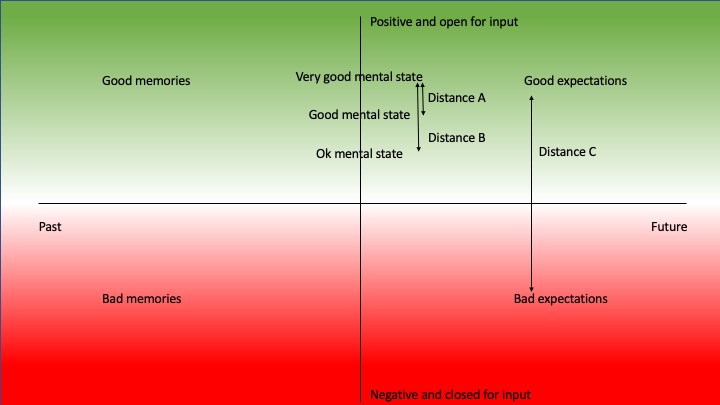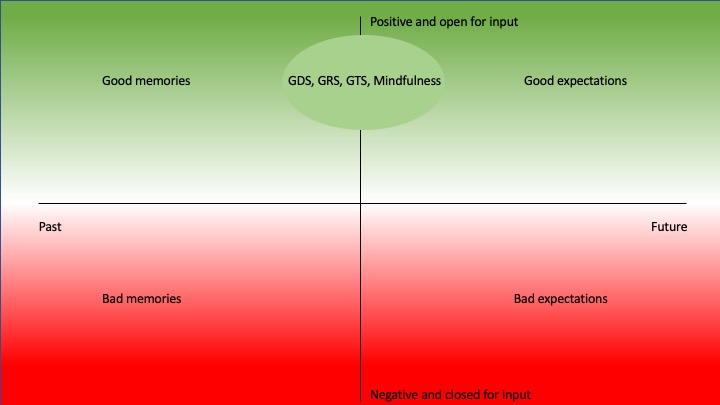Balance your level of tension or find the level that works for your golf game. You could call it tension management, excitement management or anxiety management.
Performance in golf depends on many things and the level of arousal is one of them. You can be in a mental state where you give up and do not care at all. That can be too little excitement. Alternatively, you can be in a mental state where you are much too excited. None of the two works for golfing but there are levels of excitement in between that works well. There is in other words an optimal level of excitement that is just the right level of excitement for the situation and the performance in that specific situation. The difficult thing is that it is not always the same level of excitement. Sometimes you need to get your excitement up and sometimes you need to get your excitement down. At the same time, you need to be in the green zone no matter which level of excitement you want.
16.1. Illustration: Optimal anxiety
Optimal anxiety is much about managing your expectations and your memories. Take a look at the below illustration 16.1. and imagine you are on the golf course. You are going to hit your golf ball in a couple of moments. Your task now is to select the mental state you want to be in. Which mental state do you chose?

Source: Acuity World
Let’s say you chose to be in very good mental state before you strike your golf ball. The distance you need to cover in order to get in very good mental state is distance A, B or C, depending on the mental state you are in already before you strike the golf ball. At the same time, you want to use as little mental energy as possible, and we know that the happier you are the less energy you use.
We also know how difficult it is to cover distance C. Just think of it. When in a bad mood and trying to become a happy. How does that work? It is not easy and the more we dig into the bad mood the more difficult it is to get out of it again. This is why in golf we need to be in a good mental state all the way around the golf course. Off course, we get frustrated when we make a bad stroke. We can then choose to remember that bad stroke and stay in that bad mood and the bad mental state for the rest of the round or for the next couple of holes. What is that going to do to our game?
Moreover, we can decide to postpone our shift from the bad mental state to the good mental state until we need it for the next golf shot. Meaning, cover distance C rather than distance A. That would give us less time to cover the longer distance.
All in all, the optimal place to be is in the good mental state and you need to be there as much as possible.
Elite athletes who have been in the zone report that they experienced balance of excitement, awareness, concentration, calmness, and a full immersion in the sport. They are so focused that they forget parts of the golf round. Tiger Woods among others talk about this. The high level of skill mastery becomes automated. Tiger Woods even tells us that he from time to time cannot recollect parts of the round because he was captivated by the situation on the golf course.
The books Inner Game of Golf and Zen Golf turns this around and leave out technical swing thoughts altogether.
I know a couple of golfers who were about to give up golf entirely. They read the book Inner Game of Golf, stopped thinking about the techniques and got back into good golfing. One of them played at a handicap between 7 and 8 after having read the book.
16.2 Which mental state do you select and prefer for your game
The good thing about deciding and selecting the mental state of mind you want to be in is that we have several techniques that we can use, and they are all good mental states in the green positive area where we are open for input and new data.
16.3. Illustration: Select your mental state

Source: Acuity World
The illustration shows you that all the techniques and mental states mentioned in this book will bring you to the good mental state in the green area. To get there does off course require that you do not have a medical condition. It also requires some practise with the correct details in the techniques. That said, if you do it right and train it, it will bring you good results and good joy on the golf cause as well as other places.
Here are the full names of the mental states we covered in the book:
- GDS, General Desired State.
- Exercise 1.
- GTS, Greater Than Self.
- Exercise 6.
- GRS, General Relaxed State.
- Exercise 7.
- Mindfulness:
- Breathing technique.
- Exercise 2.
- Full body scan.
- Exercise 4.
- Quick body scan.
- Exercise 5.
- Refocus with mindfulness.
- Exercise 8.
- Breathing technique.
